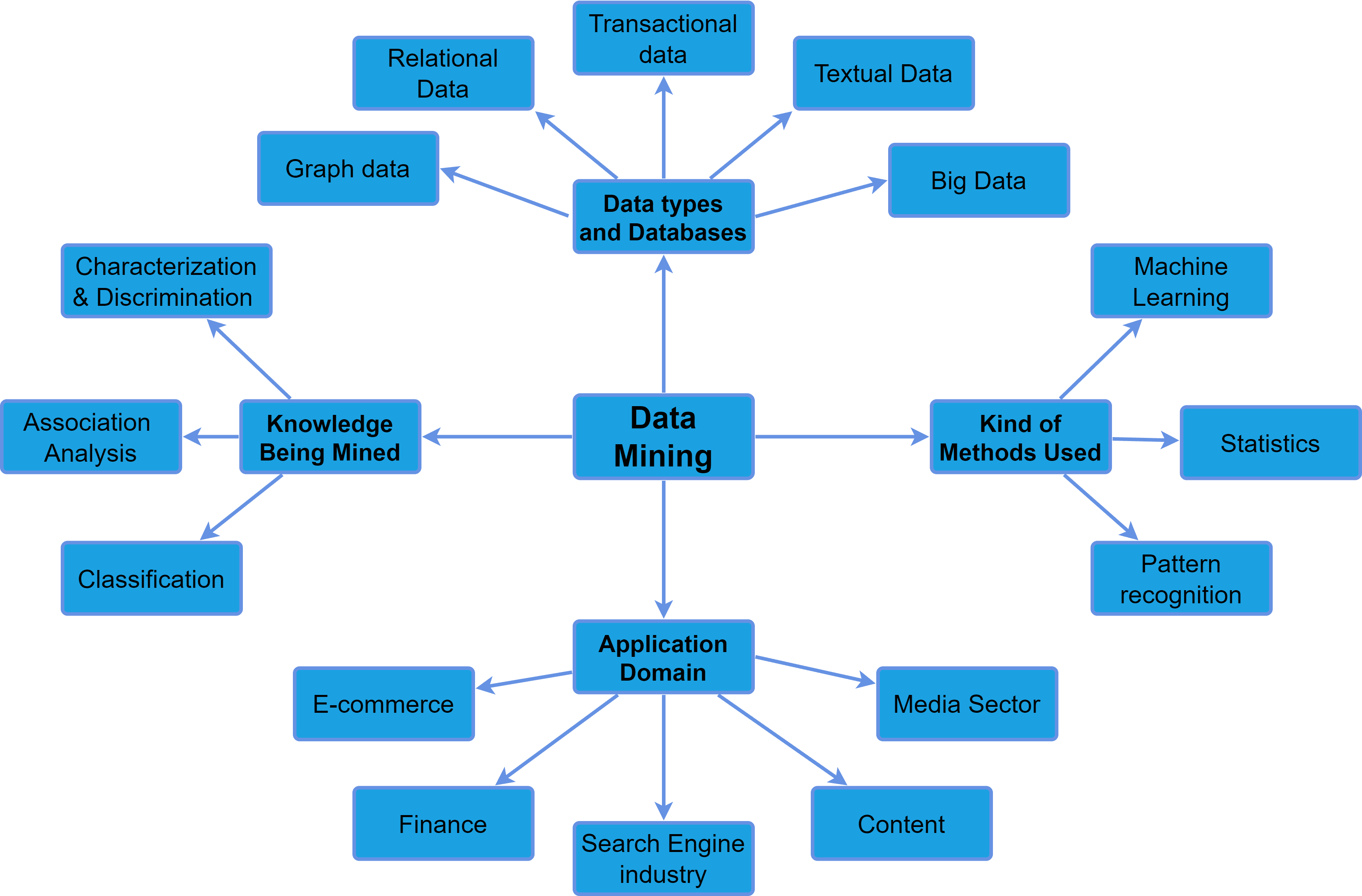1. Overview
In this tutorial, we’ll explore the classification of data mining (DM) systems. We must first understand the classification of data mining systems to optimize the data mining process. Once we understand these systems, we can select the appropriate one for a specific task. Selecting the appropriate system is essential for achieving the best results in the data mining process.
2. Classifying Data Mining Systems
Data mining discovers patterns and extracts useful information from large datasets. Organizations need to analyze and interpret data using data mining systems as data grows rapidly. With an exponential increase in data, active data analysis is necessary to make sense of it all. Data mining (DM) systems can be classified based on various factors.
In order to provide the roadmap for the rest of the article, let’s present the visualization of DM classification. It starts with the center, which is DM; the next level of this hierarchy represents the type of classes, while the last level of leaves is classes of the taxonomy:

2.1. Type of Data and Database Being Mined
Relational data is commonly found in relational databases, where structured and organized information is stored in tables with columns and rows. Data mining practitioners frequently use tools like SQL to work with this type of data. Meanwhile, transactional data focuses on events or transactions occurring over time, such as customer purchases. Practitioners use methods like pattern identification and trend analysis to gain valuable insights from this data.
Textual data, on the other hand, encompasses unstructured or semi-structured text. They originate from sources like emails, news articles, and product descriptions. Data mining methods such as sentiment analysis and topic modeling can be applied to this type of data.
Graph data structures, which represent networks and graphs as data structures with strong explanatory power, are another important category. Community detection and link prediction are typical data mining methods used with this data type.
Lastly, big data refers to the processing of extremely large amounts of data that traditional data mining methods cannot handle. Industries utilize big data technologies like Hadoop and Spark to manage and analyze these massive datasets. By doing so they ensure that valuable insights can still be extracted from them.
The type of data and database systems play a significant role in shaping data mining systems. Consequently, they directly impact the efficiency and effectiveness of extracting valuable insights from vast amounts of information. In conclusion, various data types and structures require the use of different algorithms and techniques for successful data mining.
2.2. Knowledge Mined
Identifying the specific type of knowledge that data mining systems are mining is crucial. This enables these systems to concentrate on extracting relevant information and patterns, ultimately helping them achieve their intended goals.
Various data mining methods aim to summarize the general features of the input dataset, such as calculating and visualizing distributions, frequencies of occurrences, and other advanced statistics.
On the other hand, identifying the characteristics that set one group of data apart from another is the focus of discrimination.
Data scientists use association rule mining and correlation analysis to identify relationships between variables in a dataset, revealing items that are frequently purchased together, for example.
Assigning a label or category to a new observation is another important task in data mining. The main method of doing so is using similarity to existing labeled observation. Data scientists can use tools such as decision trees, neural networks, and support vector machines for classification.
Lastly, identifying changes in a dataset over time is the focus of evolution analysis. This could include changes in customer behavior or stock prices.
2.3. Kind of Methods Used
Similarly, DM systems use various techniques, including machine learning, mathematical techniques, and pattern recognition.
Machine Learning algorithms learn patterns and relationships in data without explicit programming and can classify data, either supervised or unsupervised. Statisticians analyze data and make inferences about populations by examining data samples using mathematical techniques.
Pattern recognition is a common technique where algorithms identify patterns in data, such as handwriting or facial recognition. Data analysts apply methods like decision trees, neural networks, and support vector machines to achieve this goal. Therefore, users can determine the optimal approach for their specific data analysis requirements by examining the methods. Examining the methods enables users to gain more accurate and actionable insights.
2.4. Application Domain
Data mining experts categorize data mining systems based on the application domain, and various industries utilize these systems. For instance, e-commerce heavily relies on data mining to examine customer behavior, preferences, and buying patterns, helping businesses better serve their clientele.
Similarly, financial firms use data mining to study financial data such as stock prices and economic indicators, make predictions about market trends, and pinpoint profitable investment opportunities. The search engine industry also analyzes user queries and search histories using data mining, improving the relevance of search results.
In the medical sector, researchers analyze large datasets of patient information using data mining to identify risk factors and create predictive models for diseases. The media sector also takes advantage of data mining to analyze user engagement, preferences, and consumption patterns, tailoring content to better appeal to their audience.
We ensure that we tailor the chosen data mining techniques to the distinct challenges and goals of the domain in question through this classification of DM. Consequently, experts can streamline their efforts, optimize resource allocation, and maximize the value of the insights derived from the mined data by using this classification process.
3. Conclusion
In this article, we have discussed the classification of data mining systems based on different criteria. Organizations can choose the most suitable data mining techniques for their specific needs and goals by understanding these classifications.